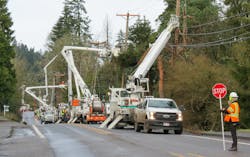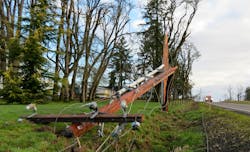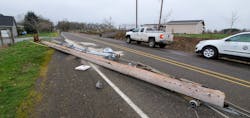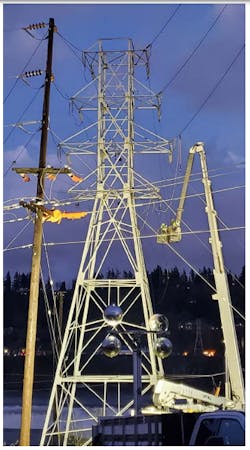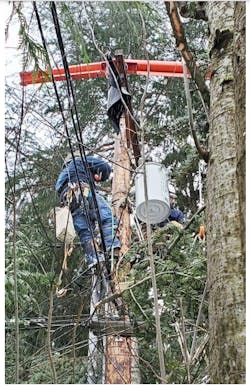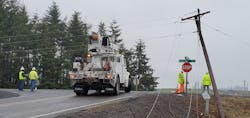Winter Storm Uni plunged the nation into a deep freeze. Temperatures dipped below zero as snow blanketed the roads and ice coated tree limbs and power lines. In the aftermath of the storm, electric utilities experienced its impact from coast to coast.
During a five-day stretch—from Feb. 12 to 16—some states faced record low temperatures, heavy snowfall and ice accumulation. In Oregon, ice was an inch thick or more in some areas, Ohio reported 14 in. from a two-day snowfall and Oklahoma City, Oklahoma, had 2 ft to 4 ft snow drifts, according to the Weather Channel. Nearly 80% of the state of Texas was blanketed by snow, and some cities reported the lowest temperatures in decades.
In the first part of our storm series, we will highlight restoration efforts in Oregon in Portland General Electric’s service territory, where temperatures dropped to the lower 20s, with some areas experiencing subzero wind chills.
Coming Together to Restore Power
Ice accumulations peaked at 1.5 in. near Oregon City, Ore. and up to a foot of snow fell across the Northern, Central, and Eastern Portland, Ore. metropolitan area, with nearly 3 ft of snow over parts of the Mt. Hood Corridor.
Nearly half of Portland General Electric’s (PG&E’s) customers—421,649—lost power at some point due to the February storms. More than 100,000 of that number experienced multiple outages. In fact, some customers experienced up to six power outages as a result of the winter storm.
At peak of the recovery effort, PGE had more than 400 crews actively working on restoration, including line, tree crews and wire down crews, making for the largest mobilization in the utility’s history. Over the course of the restoration effort, PGE’s line crews restored 750,000 customer outages.
In addition to PGE’s linemen, mutual aid crews joined the restoration effort from elsewhere in Oregon, as well as Washington, Montana, California, Nevada and British Columbia. To coordinate the crews, PGE used myWorld viewer software, which allowed the utility to better dispatch, prioritize and better inform crews of the work and share information.
Any large outage event requires a prioritization plan, and for PGE, the first step is knowing what they’re up against. The utility relies upon on a team of employees to provide initial damage assessment, and in this storm, that required eight times more employees than a normal large outage.
Once the prioritization plan was in place, the utility worked the plan. At a high level, the plan starts with generation to transmission to substations and distribution and ends at the community EMS facilities and the customers’ businesses and homes.
Overcoming Obstacles
Overall, PGE’s system experienced roughly 10 times more damage than in its most recent 2020 Labor Day wind and wildfire event. Ice added as much as 1,000 pounds of extra weight to each span of wire in some areas, pole to pole.
“This was a historic weather event and introduced new variables that challenged our system,” says Steve Corson, PGE spokesperson. “In this storm, the weight of the ice on our lines, especially when coupled with the weight of the ice on the falling trees and branches, damaged the lines and also broke and/or ripped out many of our poles. The ice also impacted trees, often bending them in ways that threatened our equipment.”
Because crew and customer safety are a number one priority for PGE, this set of storms presented challenges to crews in even safely accessing some of the damaged areas to begin repairs. Due to extremely dangerous conditions as a result of falling trees and limbs, PGE was unable to safely send crews to the hardest hit areas for the first 48 hours. The utility experienced three straight days of hazardous conditions as a result of the vegetation damage, slowing its ability to make progress.
In any ice event, employees are required to wear shoe chains and spikes to safely stay upright. Every piece of equipment and rolling stock needs their own set of chains and traction devices.
“The ice affects every part of getting work done,” Corson says. “From the first step to the last, ice makes electrical work extremely dangerous and requires exceptional focus on every detail, every minute. In this storm, we couldn’t enter certain areas due to falling trees, limbs and ice. And because we had three storms in a row, this was a big factor in what areas we could safety work.”
Taking a Proactive Approach
After focusing its time and energy on restoring power for its customers, the utility is now beginning to evaluate what if anything it should do differently to continue working toward the overall optimal system.
“It is always a balance of increasing sometimes competing resiliency needs while also keeping costs affordable for our customers,” Corson says. “For instance, if you put up tree wire—special, heavily-insulated wire—that helps with wildfire prevention but is less resilient in an ice storm because it is much heavier.”
The utility typically trims its trees on a three-year cycle, but with warming temperatures, PGE is seeing indications that a two-year cycle may be imminent. PGE has also doubled the amount spent on tree-trimming and vegetation management since 2017 to $26 million in 2020. PGE is also working closely with cities and municipalities on helping educate customers about planting the right tree types under or near power lines to help get ahead for the future.
As part of its wildfire prevention efforts, PGE has expanded its vegetation management program to trim and remove more trees and shrubs that are overgrown, dead, dying or showing growth defects that can impact overhead power lines. PGE manages more than 2 million trees along 12,000 miles of overhead power lines.
Through these proactive efforts, PGE will be ready for whatever severe winter weather roars into its service territory in the years ahead.
About the Author
Amy Fischbach
Electric Utilities Operations
Amy Fischbach is the Field Editor for T&D World magazine and manages the Electric Utility Operations section. She is the host of the Line Life Podcast, which celebrates the grit, courage and inspirational teamwork of the line trade. She also works on the annual Lineworker Supplement and the Vegetation Management Supplement as well as the Lineman Life and Lineman's Rodeo News enewsletters. Amy also covers events such as the Trees & Utilities conference and the International Lineman's Rodeo. She is the past president of the ASBPE Educational Foundation and ASBPE and earned her bachelor's and master's degrees in journalism from Kansas State University. She can be reached at [email protected].



